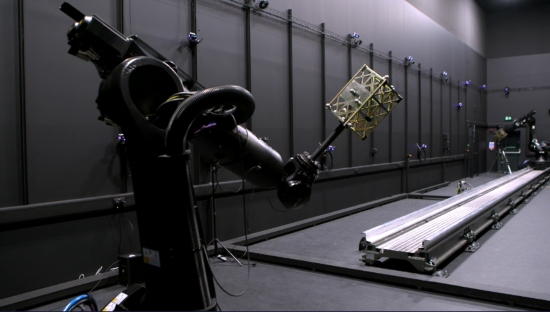
![]()
From maintaining spacecraft to exploring distant planets, robots play a pivotal role in overcoming the challenges of space environments. But how do we ensure these systems are as precise and adaptable as possible?
Enter motion capture (mocap), a tool that has more typically been associated with transforming industries like film and gaming and is now set to propel space robotics into a new era of innovation. The same technology that brought characters from shows such as The Mandalorian to life is being applied in a groundbreaking initiative to tackle the challenges of satellite maintenance and construction in space.
Learnings from simulated inspection, repair, and assembly operations will help improve the robotic systems that keep satellites operational and lay the groundwork for the development of next-generation orbital infrastructure.
High-stakes engineering
There’s a large facility in Westcott, Buckinghamshire, where no one can hear you scream. Well, theoretically. The In-Orbit Servicing and Manufacturing (IOSM) Yard replicates space on Earth. It’s one of nine centres in the Satellite Applications Catapult network – a government-backed initiative designed to foster homegrown innovation in space technology.
![]() Built to recreate the harsh conditions of space, this cutting-edge testing facility aims to extend satellite lifespans, clear orbital debris, and enable the construction of massive space structures. Mocap technology sits at the heart of its operations, with 33 Vicon Vero cameras capturing the action across an indoor space spanning 27m by 7m, and 8m in height.
Built to recreate the harsh conditions of space, this cutting-edge testing facility aims to extend satellite lifespans, clear orbital debris, and enable the construction of massive space structures. Mocap technology sits at the heart of its operations, with 33 Vicon Vero cameras capturing the action across an indoor space spanning 27m by 7m, and 8m in height.
The technology used by the centre is identical to that in the film industry – the same cameras, markers, and even some of the same software – and is similarly meant to capture precise movement.
The precision and reliability of Vicon’s mocap system is founded on years of research and validation in life sciences, where exacting standards are essential for clinical and biomechanical applications. The same cameras, markers, and software that monitor human movement in labs worldwide are now ensuring that test robots in the IOSM Yard can perfectly replicate the tasks they will perform in orbit.
Precision simulation
Precision is crucial: the test robots must perfectly replicate the interaction between the IOSM robot and the satellite, ensuring zero margin for error when it comes to the real operation. Robots must carefully work around fragile components like antennas and radar dishes – any deviations not accounted for in testing could result in costly damage to the satellite and result in harmful space debris.
Vicon’s motion capture technology provides the “ground truth” data needed to validate navigation and control systems with scientific rigour. Drawing on experience from the life sciences sector, the mocap data is capable of fine-tuning sensor systems and enhance location algorithms, guaranteeing the highest levels of accuracy required for high-stakes space missions.
Advancing human capabilities
Mocap technology isn’t just critical in test environments – it’s becoming essential in live space missions as well.
Astronauts and ground operators now use motion-capture suits that translate human gestures into precise robotic commands aboard the International Space Station. Building on the accuracy previously seen in life sciences applications, such as injury prevention and rehabilitation for athletes, the tech enables the seamless control of robotic components, drones, and landers on satellites, space stations, and even distant planets.
What’s more, mocap facilitates more fluid and natural interactions between astronauts and robots by interpreting human gestures, movements, and body language. Robots equipped with AI can respond dynamically to these inputs, fostering more intuitive, human-robot collaboration in zero-gravity environments.
In these ways, mocap plays a pivotal role in increasing the efficiency of space exploration, enabling astronauts to perform complex tasks – from sample collection to construction – remotely and safely, pushing the boundaries of what’s possible in space missions.
Future of space robotics
From astronaut training and robotic exoskeletons to autonomous systems, mocap technology is driving exciting advancements in the space economy. By merging real-time motion data, AI, and robotics, the industry is poised to redefine the limits of human activity in space.
What was once the realm of science fiction is rapidly becoming a reality, unlocking new possibilities for future space operations.
![]() By Felix Tsui, New Life Sciences Product Manager at Vicon
By Felix Tsui, New Life Sciences Product Manager at Vicon








